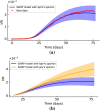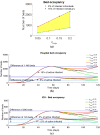Optimal control of the COVID-19 pandemic: controlled sanitary deconfinement in Portugal
- PMID: 33568716
- PMCID: PMC7876047
- DOI: 10.1038/s41598-021-83075-6
Optimal control of the COVID-19 pandemic: controlled sanitary deconfinement in Portugal
Abstract
The COVID-19 pandemic has forced policy makers to decree urgent confinements to stop a rapid and massive contagion. However, after that stage, societies are being forced to find an equilibrium between the need to reduce contagion rates and the need to reopen their economies. The experience hitherto lived has provided data on the evolution of the pandemic, in particular the population dynamics as a result of the public health measures enacted. This allows the formulation of forecasting mathematical models to anticipate the consequences of political decisions. Here we propose a model to do so and apply it to the case of Portugal. With a mathematical deterministic model, described by a system of ordinary differential equations, we fit the real evolution of COVID-19 in this country. After identification of the population readiness to follow social restrictions, by analyzing the social media, we incorporate this effect in a version of the model that allow us to check different scenarios. This is realized by considering a Monte Carlo discrete version of the previous model coupled via a complex network. Then, we apply optimal control theory to maximize the number of people returning to "normal life" and minimizing the number of active infected individuals with minimal economical costs while warranting a low level of hospitalizations. This work allows testing various scenarios of pandemic management (closure of sectors of the economy, partial/total compliance with protection measures by citizens, number of beds in intensive care units, etc.), ensuring the responsiveness of the health system, thus being a public health decision support tool.
Conflict of interest statement
The authors declare no competing interests.
Figures





Similar articles
-
Predicting the evolution and control of the COVID-19 pandemic in Portugal.F1000Res. 2020 Apr 23;9:283. doi: 10.12688/f1000research.23401.2. eCollection 2020. F1000Res. 2020. PMID: 32983416 Free PMC article.
-
Travel-related control measures to contain the COVID-19 pandemic: a rapid review.Cochrane Database Syst Rev. 2020 Oct 5;10:CD013717. doi: 10.1002/14651858.CD013717. Cochrane Database Syst Rev. 2020. Update in: Cochrane Database Syst Rev. 2021 Mar 25;3:CD013717. doi: 10.1002/14651858.CD013717.pub2. PMID: 33502002 Updated.
-
Social Restrictions versus Testing Campaigns in the COVID-19 Crisis: A Predictive Model Based on the Spanish Case.Viruses. 2021 May 15;13(5):917. doi: 10.3390/v13050917. Viruses. 2021. PMID: 34063465 Free PMC article.
-
Predicting COVID-19 spread in the face of control measures in West Africa.Math Biosci. 2020 Oct;328:108431. doi: 10.1016/j.mbs.2020.108431. Epub 2020 Jul 29. Math Biosci. 2020. PMID: 32738248 Free PMC article.
-
International travel-related control measures to contain the COVID-19 pandemic: a rapid review.Cochrane Database Syst Rev. 2021 Mar 25;3(3):CD013717. doi: 10.1002/14651858.CD013717.pub2. Cochrane Database Syst Rev. 2021. PMID: 33763851 Free PMC article.
Cited by
-
Mathematical modeling and optimal intervention strategies of the COVID-19 outbreak.Nonlinear Dyn. 2022;109(1):177-202. doi: 10.1007/s11071-022-07235-7. Epub 2022 Jan 30. Nonlinear Dyn. 2022. PMID: 35125654 Free PMC article.
-
Recent advances in the vaccine development for the prophylaxis of SARS Covid-19.Int Immunopharmacol. 2022 Oct;111:109175. doi: 10.1016/j.intimp.2022.109175. Epub 2022 Aug 17. Int Immunopharmacol. 2022. PMID: 35994853 Free PMC article. Review.
-
Vaccine Hesitancy and Anti-Vaccination Attitudes during the Start of COVID-19 Vaccination Program: A Content Analysis on Twitter Data.Vaccines (Basel). 2022 Jan 21;10(2):161. doi: 10.3390/vaccines10020161. Vaccines (Basel). 2022. PMID: 35214620 Free PMC article.
-
From node to network: weaving a global perspective on efficacy and costs of non-pharmaceutical interventions.Sci Rep. 2025 Jan 22;15(1):2844. doi: 10.1038/s41598-025-87566-8. Sci Rep. 2025. PMID: 39843823 Free PMC article.
-
Optimal control and cost-effectiveness analysis for a COVID-19 model with individual protection awareness.Physica A. 2022 Oct 1;603:127804. doi: 10.1016/j.physa.2022.127804. Epub 2022 Jun 22. Physica A. 2022. PMID: 35757186 Free PMC article.
References
-
- COVID-19 Coronavirus Pandemic. https://www.worldometers.info/coronavirus/ (2020).
-
- República Portuguesa, Ministério da Educação, XXII Governo. Comunicação enviada às escolas sobre suspensão das atividades com alunos nas escolas de 16 de março a 13 de abril. https://www.portugal.gov.pt/pt/gc22/comunicacao/documento?i=comunicacao-... (2020).
-
- Capacidade de Medicina Intensiva aumentou 23%. https://covid19.min-saude.pt/capacidade-de-medicina-intensiva-aumentou-23/ (2020).
-
- Metcalf CJE, Morris DH, Park SW. Mathematical models to guide pandemic response. Science. 2020;369:368–369. - PubMed
Publication types
MeSH terms
Grants and funding
LinkOut - more resources
Full Text Sources
Other Literature Sources
Medical

